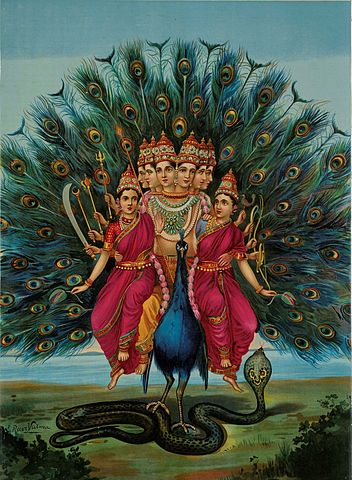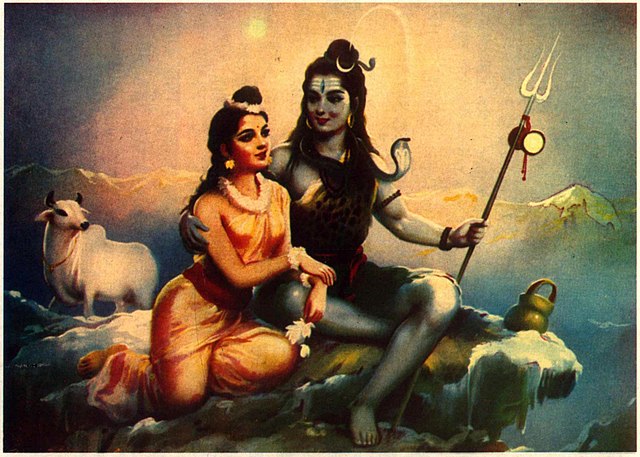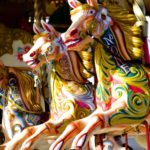Just as the Rashis have lords, the 27 Nakshatras also have lords assigned to them. The characteristics of the Nakshatra correspond not only to their Rashi lord but also to their Nakshatra lords.
The 12 astrological signs or Rashis are the divisions of the 360 degrees of the zodiac into 12 equal sections of 30 degrees each. These Rashis are assigned lord who are either the Sun, Moon, Mars, Mercury, Jupiter, Venus or Saturn. The nodes Rahu and Ketu are also mentioned as co-lords of certain Rashis in some texts.

Nakshatras are the division of the 360 degrees of the zodiac into 27 equal sections. Each of these sections is associated with a star or a group of stars. Nakshatra translates as ‘that which doesn’t move’. However, the most commonly used term for Nakshatras is ‘lunar mansions’. The interpretation of the Nakshatras also adds a layer of detail to the reading of a horoscope in Vedic astrology.
Nakshatras And Nakshatra Lords
The division of 360 degrees into 27 sections makes each section 13 degrees and 20 minutes of a Nakshatras. Each Nakshatra has a lord. However, Nakshatra lords include the lunar nodes Rahu and Ketu. The order of the lord assignment is the very same as the Dasha order in the Vimshottari Dasha system; Ketu, Venus, Sun, Moon, Mars, Rahu, Jupiter, Saturn as well as Mercury. This Dasha system depends on the Nakshatra in which the Moon is placed in a birth chart. Therefore, the first Dasha in the Vimshottari Dasha system is the Dasha of the Moon Nakshatra lord. Vedic astrology also studies the Nakshatra and the Nakshatra lord of each planet placement for a detailed reading.
Nakshatra Padas
Each Nakshatra is divided into four Padas that are 3 degrees and 20 minutes each. These Padas may fall in different Rashis for certain Nakshatras. So, the Nakshatra lord for all the four Padas of a Nakshatra will be the same. However, different Padas might have different Rashi lords. Both the Rashi and the Nakshatra lordships play a very important role in the interpretation of the horoscope.
Nakshatra Lord Table
| No. | Nakshatra | Lord |
| 1 | Ashwini | Ketu |
| 2 | Bharani | Venus |
| 3 | Krittika | Sun |
| 4 | Rohini | Moon |
| 5 | Mrigashirsha | Mars |
| 6 | Ardra | Rahu |
| 7 | Punarvasu | Jupiter |
| 8 | Pushya | Saturn |
| 9 | Ashlesha | Mercury |
| 10 | Magha | Ketu |
| 11 | Purvaphalguni | Venus |
| 12 | Uttaraphalguni | Sun |
| 13 | Hasta | Moon |
| 14 | Chitra | Mars |
| 15 | Swati | Rahu |
| 16 | Vishakha | Jupiter |
| 17 | Anuradha | Saturn |
| 18 | Jyeshta | Mercury |
| 19 | Mula | Ketu |
| 20 | Purvashadha | Venus |
| 21 | Uttarashadha | Sun |
| 22 | Shravana | Moon |
| 23 | Dhanistha | Mars |
| 24 | Shatabhishak | Rahu |
| 25 | Purvabhadrapada | Jupiter |
| 26 | Uttarabhadrapada | Saturn |
| 27 | Revati | Mercury |
So, of the 27 Nakshatras, the Sun-ruled Nakshatras are Krittika, Uttaraphalguni and Uttarashda. These Nakshatras have Padas that fall across Rashi borders. So, even though the Nakshatra itself comes under the influence of the Nakshatra lord, Sun, the Rashi lord for the first Pada of Krittika, Uttaraphalguni and Uttarashada is different from the Rashi lord of the second, third and fourth Padas.
Krittika – The Cutter
Krittika is the Nakshatra that spans 26 degrees 40 minutes Aries to 10 degrees Taurus. The word Krittika means to cut. It is the star of cutting and also of fire. It is located in a group of six stars that are astronomically known as the Pleiades. Krittika is also symbolised by a sharp object or a knife. Agni, the God of sacred fire is the deity of Krittika. This adds the signification of the power to burn (Dahana Shakti) to this Nakshatra. This burning could be for purification and also for cooking and nourishment. So, this is the Nakshatra that has the power to burn or cut away that which is not necessary and thus purify. This gives the ability to discern as well as great powers of perception. Moreover, just like a fire that burns out of control, this Nakshatra has a problem with an uncontrollable appetite.

The first Pada of Krittika is in Mesha/Aries and this section of the Nakshatra is under the influence of both the Sun as well as Mars (lord of Aries). This gives a fiery and bold leadership influence to this Pada. The second, third and fourth Padas are in Rishaba/Taurus and have a more Venusian influence that is softer than the first Pada. Hence, these three Padas have a great appreciation for beauty and the fine arts.
The Sun influence gives qualities of leadership and independence to this Nakshatra. They are able to get to the heart of the matter, have a strong desire for change and are also very straightforward. On the negative side, there may be issues with controlling the appetite, illicit relationships, over aggression and temper issues.
Murugan – Krittikas
According to the legend of the birth of Lord Muruga/Kartikeya, he was raised by the six Krittika stars. This also symbolises the nurturing quality of this Nakshatra that is not immediately obvious because of the rather harsh first impression. It may also imply illegitimate or adopted children. Krittika is also called Karthigai in Tamil and Malayalam.

- Deity: Agni
- Rashi Degrees: 26 degrees 40 minutes Aries to 10 degrees Taurus
- Animal Symbol: Female Sheep
- Nature: Rakshas (Demon)
- Power: the power to burn (Dahana Shakti)
- Symbol: Razor, flame
- Good For: Cutting oneself away from bad habits, cleaning/organising, debate, argument, cutting, shaving, sewing, cooking, fasting and for a protest.
- Not Good For: pleasurable and relaxing activities
- Dosha: Kapha
- Guna: Kama
- Motivation: Rajas
- Direction: South-East
Uttaraphalguni – Fig Tree Or The Latter Reddish One
This is the twelfth Nakshatra that is partly in the Rashi of Simha/Leo and Kanya/Virgo. This Nakshatra spans the Simha/Leo and Kanya/Virgo Rashis. It is located at the stars Denebola (Beta-Leonis) and 93-Leonis. The symbol of this Nakshatra is the back legs of a bed which indicates rest and pleasure. This Nakshatra is also called Uthiram in Tamil and Malayalam.
The power of this Nakshatra is to gain power through partnership or marriage (Chayani Shakti). The previous Nakshatra of Purvaphalguni signifies the marriage or union. This Nakshatra of Uttaraphalguni is described as the setting up of the new couples’ household or the marriage bed which is after the marriage ceremony. The deity of this Nakshatra is Bhaga. He is associated with friendship, favours, kindness, inheritance, contracts and unions as well as prosperity through unions. So, on one level this Nakshatra could indicate gain through inheritance and on the other hand gain through marriage.

Weakness
Lord Shiva and Shakti married under this Nakshatra. This is therefore an added symbolism of how important family and marriage is to this Nakshatra. This Nakshatra gives great love as well as a protective nature towards animals. They also have a tendency towards social work and helping others. This Nakshatra tends to be over-dependent on partnerships and relationships. They tend to feel very lonely or incomplete when single. They tend to give too much in a relationship while at the same time being ungrateful to their partners and those who lend them a helping hand.
The first Pada of Uttaraphalguni is in Simha. It is influenced by the Sun as both the Nakshatra as well as the Rashi lord. All Uttaraphalguni natives have strong leadership qualities but the first Pada shows a very determined person who is able to overcome any obstacle in their way. The second, third as well as the fourth Padas are under the influence of the Sun as the Nakshatra lord and Mercury as the Rashi lord making them more detail-oriented and interested in research.
- Deity: Bhaga
- Rashi Degrees: 26 degrees 40 minutes Leo to 10 degrees Virgo
- Animal Symbol: Male Cow
- Nature: Manushya (human)
- Power: to gain power through partnership or marriage (Chayani Shakti)
- Symbol: Back legs of a bed or cot
- Good For: Since this is a fixed Nakshatra it is good for anything that is meant to be permanent. Marriage laying foundations, starting good deeds, planting, sowing, purchase of land, sex, wearing new garments and jewels.
- Not Good For: Harsh and destructive acts, lending money, trying to end or complete something.
- Dosha: Vata
- Guna: Moksha
- Motivation: Rajas
- Direction: East
Uttarashada – Final Victory/ Universal Star
Uttarashada is the 21st Nakshatra and is called “The Later Unconquered One”. Purvashada and Uttarashada are a pair of Nakshatras. Uttarashada translates as the latter or the final victory. It is symbolised by the planks of a bed and also the tusk of the elephant. We can link this to the times when elephants were used in wars and how efficiently the elephant used its tusks to defeat the opposition in a fight. It is also a Nakshatra that symbolises royalty and leadership. With Sun being the Nakshatra lord it is clear to see why this Nakshatra has such good leadership skills and since they connect with people easily, they make good politicians too. This Nakshatra is also called Uthiradam in Tamil and Malayalam.

Power And Motivation
The Vishwa Devas are the deities for this Nakshatra. These ten Vishwadevas are the sons of the God Dharma. The power of the Nakshatra is Apradhrisya Shakti which is the unchallenged victory. But, the motivation is Moksha. This Nakshatra has the ability to have big goals and ambitions as well as the perseverance to pursue them. The weakness is they that when there is no lofty goal, they can become demotivated and lazy. There is a tendency to be over dominating and to start things but not finish them as they crave the constant thrill of new goals.
Uttarashada spans 26 degrees 40 minutes Saggitarius up to 10 degrees Capricorn. Since it is in two Rashis, the Rashi lord for the different Padas are different. The first Pada is in Dhanus/ Saggitarius Rashi as well as the Dhanus Navamsa. The second, third and fourth padas are in the Rashi of Makara/ Capricorn and so the Rashi lord for these padas is Saturn. The Navamsa position for the 2, 3 and 4 Padas are Capricorn, Aquarius and then Pisces respectively. The animal is the male mongoose however, there is no counterpart for this animal among the other Nakshatras.
- Deity: The Ten Vishwadevas
- Rashi Degrees: 26 degrees 40 minutes Saggitarius to 10 degrees Capricorn
- Animal Symbol: Male Mongoose
- Nature: Manushya (human)
- Power: Apradhrisya Shakti or the unchallenged victory
- Symbol: planks of a bed and also tusk of an elephant
- Good For: Initiating all auspicious activities
- Not Good For: Travel as well as unethical and criminal acts
- Dosha: Kapha
- Guna: Moksha
- Motivation: Sattvic
- Direction: South
Read more about Krittika, Uttaraphalguni and Uttarashda.












